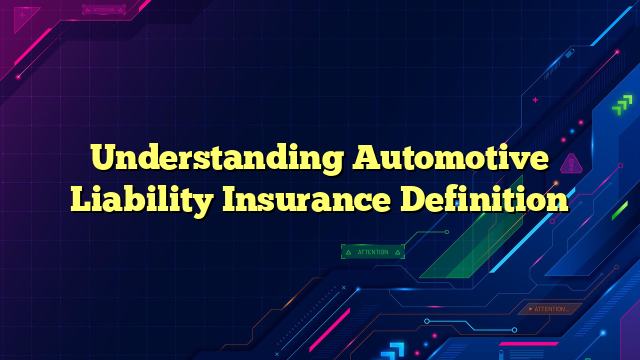As a car owner, you understand the importance of protecting your vehicle and others on the road. One way to do this is by having automotive liability insurance. But what exactly is automotive liability insurance? In this article, PortalSindo Friend, we will explore the definition of automotive liability insurance and its strengths and weaknesses.
Introduction
Hello PortalSindo Friend. Driving on the road can be unpredictable, and accidents can happen at any time. In such an event, you could be held liable for damages or injuries caused to others. This is where automotive liability insurance comes in. It is a type of insurance that covers you in the event that you are found responsible for causing damage or injury to others while driving your vehicle. Let’s explore the definition of automotive liability insurance in more detail.
What is Automotive Liability Insurance?
Automotive liability insurance is a type of insurance that covers damages or injuries caused to others by you while driving your vehicle. It is mandatory in most states, and it is designed to protect you financially in the event that you are found responsible for causing an accident.
Liability insurance typically covers two types of damages: bodily injury and property damage. Bodily injury liability covers medical expenses, lost wages, and other expenses incurred by the other party in the event of an accident. Property damage liability covers the cost of repairing or replacing the other party’s property that was damaged in the accident.
How Does Automotive Liability Insurance Work?
When you purchase automotive liability insurance, you pay a premium to the insurance company. In return, the insurance company agrees to cover you in the event that you are found responsible for causing an accident. If you are involved in an accident and found responsible for causing damages or injuries to others, your insurance company will pay for the damages up to the limit of your policy.
For example, if you have a liability limit of $50,000 for bodily injury and $25,000 for property damage, your insurance company will pay up to $50,000 for medical expenses and other expenses incurred by the other party, and up to $25,000 for repairing or replacing their damaged property.
Types of Automotive Liability Insurance
There are two main types of automotive liability insurance: bodily injury liability and property damage liability. Some states also require uninsured motorist coverage, which covers you in the event that you are involved in an accident with an uninsured driver.
Bodily injury liability covers medical expenses, lost wages, and other expenses incurred by the other party in the event of an accident. Property damage liability covers the cost of repairing or replacing the other party’s property that was damaged in the accident.
Strengths of Automotive Liability Insurance Definition
1. Protection
The main strength of automotive liability insurance is that it provides protection for you in the event that you are found responsible for causing an accident. It covers you financially, so you don’t have to worry about paying for damages out of your pocket.
2. Legal Requirements
Automotive liability insurance is mandatory in most states, so it is essential that you have it if you want to drive legally. If you are caught driving without liability insurance, you could face fines, license suspension, or even jail time.
3. Peace of Mind
Knowing that you are protected financially in the event of an accident can give you peace of mind while driving. You can focus on the road without worrying about what would happen if you were involved in an accident.
Weaknesses of Automotive Liability Insurance Definition
1. Limited Coverage
Automotive liability insurance only covers damages or injuries caused to others by you while driving your vehicle. It does not cover damages or injuries to you or your vehicle. If you want coverage for your own injuries or damages, you will need to purchase additional insurance.
2. Low Limits
The limits of liability insurance coverage are usually low, which means that they may not be enough to cover all damages or injuries caused in an accident. If the damages or injuries exceed your policy limit, you will be responsible for paying the remaining amount out of your pocket.
3. Cost
Automotive liability insurance can be expensive, especially if you have a history of accidents or traffic violations. The cost of insurance can vary widely depending on your location, age, driving history, and other factors.
Automotive Liability Insurance Definition Table
| Term | Definition |
|---|---|
| Automotive Liability Insurance | A type of insurance that covers damages or injuries caused to others by you while driving your vehicle. |
| Bodily Injury Liability | Covers medical expenses, lost wages, and other expenses incurred by the other party in the event of an accident. |
| Property Damage Liability | Covers the cost of repairing or replacing the other party’s property that was damaged in the accident. |
| Uninsured Motorist Coverage | Covers you in the event that you are involved in an accident with an uninsured driver. |
Frequently Asked Questions (FAQs)
1. Is automotive liability insurance mandatory?
Yes, automotive liability insurance is mandatory in most states.
2. What does automotive liability insurance cover?
Automotive liability insurance covers damages or injuries caused to others by you while driving your vehicle.
3. How much automotive liability insurance do I need?
The amount of automotive liability insurance you need depends on your location and other factors. You should consult with an insurance agent to determine the appropriate amount of coverage for your needs.
4. Does automotive liability insurance cover my own injuries or damages?
No, automotive liability insurance only covers damages or injuries caused to others by you while driving your vehicle. If you want coverage for your own injuries or damages, you will need to purchase additional insurance.
5. How much does automotive liability insurance cost?
The cost of automotive liability insurance can vary widely depending on your location, age, driving history, and other factors.
6. What happens if I am involved in an accident and don’t have automotive liability insurance?
If you are caught driving without liability insurance, you could face fines, license suspension, or even jail time.
7. Can I get automotive liability insurance if I have a history of accidents or traffic violations?
Yes, you can still get automotive liability insurance if you have a history of accidents or traffic violations, but it may be more expensive.
Conclusion
In conclusion, automotive liability insurance is an important type of insurance that provides protection for you in the event that you are found responsible for causing an accident. While it has its strengths, such as legal requirements and protection, it also has weaknesses, such as limited coverage and cost. It is important to understand the definition of automotive liability insurance and to determine the appropriate amount of coverage for your needs.
We hope that this article has provided you with a better understanding of automotive liability insurance. Remember, protecting yourself and others on the road is essential, and having the right insurance coverage can give you peace of mind while driving.
Disclaimer
The information in this article is for educational purposes only and should not be considered legal or financial advice. You should consult with an insurance agent or legal professional to determine the appropriate amount of coverage for your needs.






